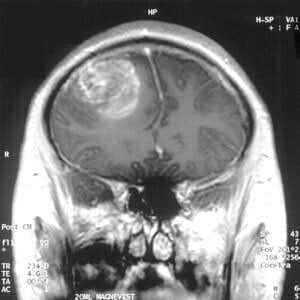
Glioblastoma is a killer and it’s personal. One of my best friends, George B., died from this devastating brain cancer. Lots of famous people have also died from malignant glioma. Senator Edward (Teddy) Kennedy is one of the most well-known victims of this brain cancer. The average survival is around 15 months after diagnosis. Senator Kennedy followed that trajectory. Senator John McCain is now battling the same glioblastoma that took my friend George and Senator Kennedy. We can’t help but wonder whether Senator McCain is getting the latest immunotherapy for this deadly disease. A new study from Duke reports significant survival stats from poliovirus therapy (New England Journal of Medicine, June 26, 2018).
The Duke Poliovirus Therapy vs. Glioblastoma
The authors of this phase 1 clinical trial start their article with this grim factoid:
“The prognosis of patients with recurrent World Health Organization (WHO) grade IV malignant glioma is dismal, and there is currently no effective therapy.”
They note that even with aggressive treatment, patients with grade IV malignant glioma rarely survive more than 20 months. When a recurrence of the brain cancer occurs, survival is usually less than a year. That’s after surgery, radiation and chemotherapy.
What They Did:
The Duke researchers recruited 61 patients with recurrent glioblastoma brain tumors. They all received a special genetically modified “nonpathogenic” polio-rhinovirus (PVSRIPO) infusion into the brain tumor. The poliovirus therapy goes after the glioblastoma cells and triggers an immune reaction.
What They Found:
Some patients did amazingly well with this poliovirus therapy. Compared to control patients who also had recurrent glioblastoma, this specialized immunotherapy produced some dramatic results. Only 4 percent of the patients who received traditional treatment survived three years. Of those who received poliovirus therapy, however, 21 percent survived three years.
The authors write:
“At the time of this writing, the survival rate at 24 months and 36 months was 21%, with patients remaining alive more than 70 months, more than 69 months, and more than 57 months after the PVSRIPO infusion.”
Those are impressive statistics. But the treatment did not work for everyone, or even the majority of patients. The final word from the Duke researchers:
“Of the 35 patients with recurrent WHO [World Health Organization] grade IV malignant glioma who were treated more than 24 months before March 20, 2018, a total of 8 patients remained alive as of that cutoff date. Two patients were alive more than 69 months after the PVSRIPO infusion. Further investigations are warranted.”
Poliovirus therapy is clearly not a cure for everyone. But this form of immunotherapy is an important advance. Why some glioblastoma patients had extraordinary outcomes and others did not remains a mystery. Genetic susceptibility may be an important factor.
Poliovirus Therapy Is Not Benign:
This new treatment did come with serious adverse reactions. Headache, weakness or partial paralysis on one side of the body, seizures, cognitive impairment, confusion, fatigue, nausea, difficulty speaking and visual disturbances are just some of the complications. If poliovirus therapy can lead to a durable remission, however, most patients would probably be willing to put up with such serious side effects.
The People’s Pharmacy Perspective:
Immunotherapy is advancing quickly on many fronts. When we first heard about poliovirus therapy we were intrigued. You can see a March 29, 2015 CBS 60 Minutes interview on this subject at this link.
There is also this update from Scott Paley of 60 Minutes on May 15, 2016:
The disappointment is that many of the various cancer immunotherapies are incredibly expensive. They also come with substantial toxicity. And they may only work for a minority of patients. We are still in the early stages of such treatments.
If you are interested in immunotherapy against cancer you may find this article of interest.
We review the work of William Coley, MD. He has been described as “The father of immunotherapy.” He began his revolutionary research in 1891. That’s right, more than 100 years ago.
Sadly, Dr. Coley’s pioneering work was pretty much ignored by his medical colleagues for over a century. Even now, the FDA, the NIH and most cancer investigators have not been willing to follow up on his ground-breaking efforts. His approach was surprisingly effective and affordable. Modern immunotherapies can cost anywhere from $150,000 to $1,000,000. We only hope that newer treatments like poliovirus therapy will continue to advance and prolong the lives of cancer patients who have no other options.

